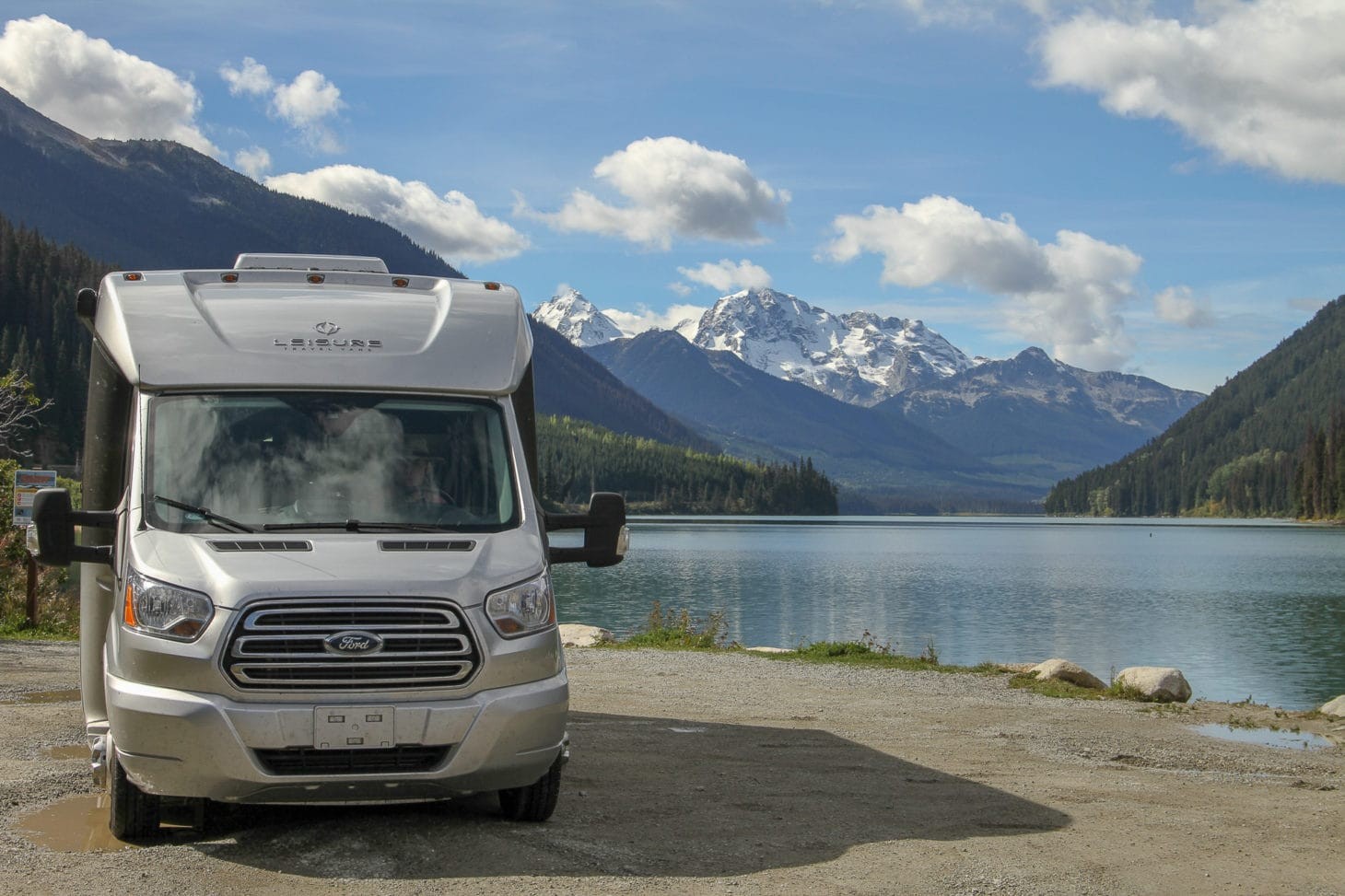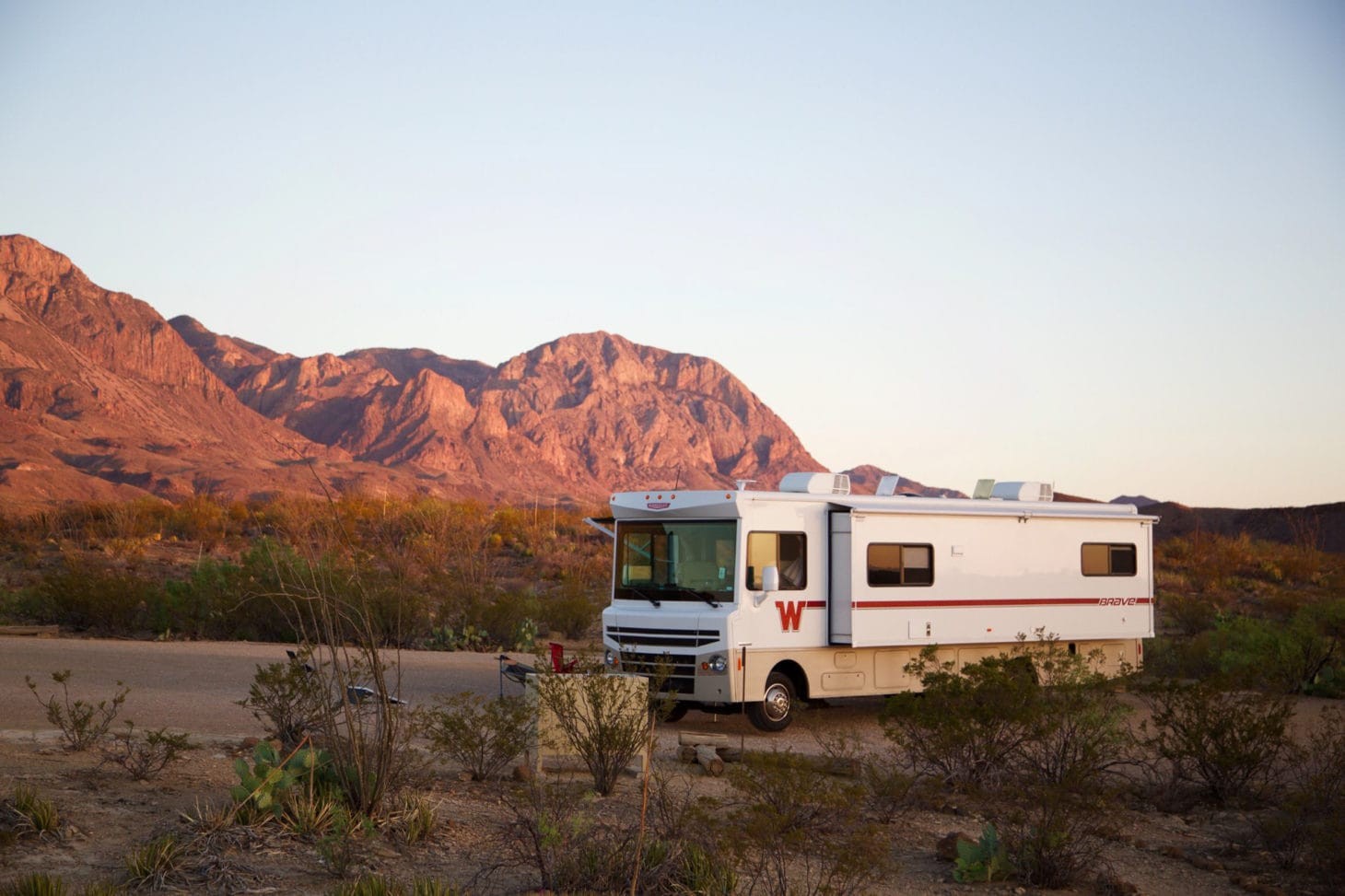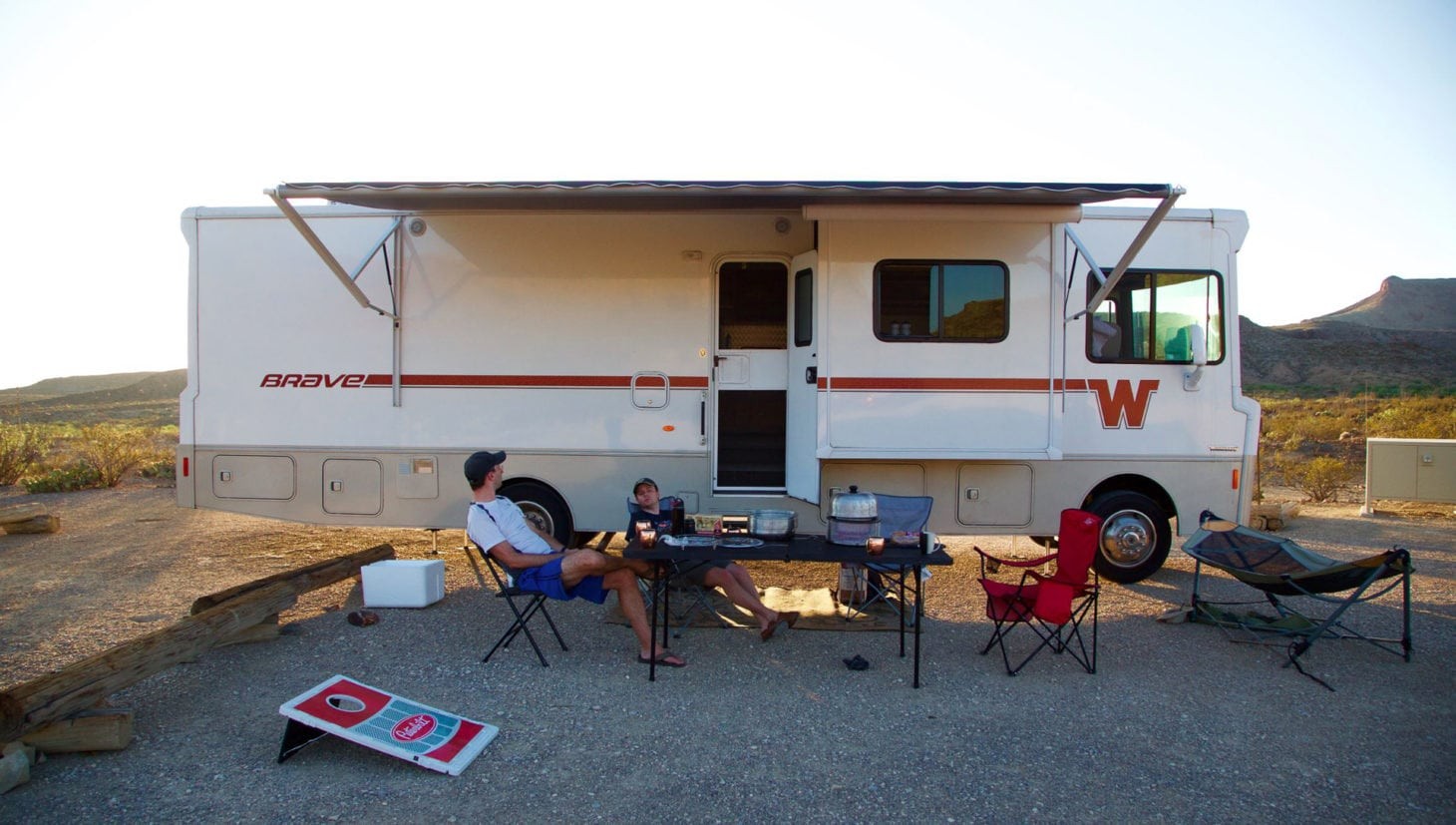Boondocking with a travel trailer opens up a world of freedom and adventure. TRAVELS.EDU.VN explores the ins and outs of dry camping, offering a guide to help you experience incredible destinations and scenic beauty, while saving money. Discover how to disconnect from crowded campgrounds and embrace the tranquility of nature, unlocking new travel possibilities, maximizing your camping experience, and accessing remote locations.
1. Understanding Boondocking with a Travel Trailer
Boondocking, also known as dry camping, refers to camping in locations without access to standard campground amenities like electrical hookups, water, and sewage disposal. This type of camping often takes place on public lands managed by the Bureau of Land Management (BLM) or in National Forests. When you boondock with a travel trailer, you are essentially self-sufficient, relying on your own resources to power your trailer, manage water, and handle waste.
1.1. Key Aspects of Boondocking
- Self-Sufficiency: This is a must. You’re responsible for all your needs.
- Location: Often on public lands, offering peace and scenic views.
- Cost-Effective: Generally free, or involves minimal fees.
- Flexibility: No need for reservations, providing spontaneity.
1.2. Boondocking vs. Traditional Camping
| Feature | Boondocking | Traditional Camping |
|---|---|---|
| Hookups | None | Electrical, water, sewage |
| Location | Public lands, dispersed areas | Designated campgrounds |
| Cost | Generally free | Higher, due to amenities |
| Reservations | Not required | Often required |
| Privacy | Greater privacy and solitude | Less privacy, more crowded |
| Self-Sufficiency | Essential | Less critical |
| Amenities | Limited or no amenities | Bathrooms, showers, etc. |
| Noise Levels | Typically quieter | Can be noisy |
2. Assessing Your Travel Trailer for Boondocking
Not all travel trailers are equally suited for boondocking. Assessing your trailer’s capabilities and making necessary upgrades is essential for a successful off-grid experience. Consider your trailer’s power capabilities, water storage, and waste management systems.
2.1. Power Systems
2.1.1. Battery Capacity
Evaluate your trailer’s battery capacity to determine how long you can operate essential appliances and devices without hookups. Deep-cycle batteries are ideal for boondocking as they can discharge a significant amount of their power without damage.
Enhancing Battery Capacity:
- Adding Batteries: Install additional deep-cycle batteries to increase your overall power storage.
- Upgrading to Lithium-Ion Batteries: Lithium-ion batteries offer higher energy density, faster charging times, and longer lifespans compared to traditional lead-acid batteries.
2.1.2. Solar Panels
Solar panels are an excellent investment for boondocking as they allow you to recharge your batteries using sunlight. Consider the size and wattage of your solar panel system to ensure it meets your power needs.
Calculating Solar Panel Needs:
- Assess Energy Consumption: Estimate your daily power consumption by listing all appliances and devices you plan to use and their wattage.
- Determine Panel Size: Calculate the necessary solar panel wattage based on your energy needs and the amount of sunlight you expect to receive.
- Consider Battery Storage: Ensure your batteries can store the energy generated by the solar panels to provide power during cloudy days or at night.
2.1.3. Generators
Generators can provide a reliable source of power for running high-wattage appliances or charging batteries when solar power is insufficient. Opt for a quiet, fuel-efficient generator to minimize noise and fuel consumption.
Generator Selection Tips:
- Noise Level: Look for generators with low decibel ratings to avoid disturbing other campers.
- Fuel Efficiency: Choose a generator that consumes less fuel to extend your boondocking trips.
- Size and Weight: Consider the generator’s size and weight to ensure it fits in your storage compartment and is easy to transport.
2.2. Water Systems
2.2.1. Fresh Water Tank Capacity
Assess the capacity of your fresh water tank and plan your water usage accordingly. Conserving water is crucial when boondocking, as you won’t have access to a continuous water supply.
Water Conservation Strategies:
- Low-Flow Fixtures: Install low-flow showerheads and faucets to reduce water consumption.
- Navy Shower: Turn off the water while soaping up during showers to conserve water.
- Dishwashing: Use a basin to wash dishes instead of running water continuously.
2.2.2. Gray and Black Water Tanks
Understand the capacity of your gray and black water tanks and how frequently you’ll need to empty them. Proper waste management is essential for responsible boondocking.
Waste Management Tips:
- Tank Monitoring: Monitor your tank levels to avoid overflows.
- Dump Stations: Locate nearby dump stations along your route for convenient waste disposal.
- Gray Water Usage: Consider using gray water for flushing the toilet to conserve fresh water.
2.3. Other Considerations
2.3.1. Insulation
Good insulation is crucial for maintaining a comfortable temperature inside your travel trailer, reducing the need for excessive heating or cooling.
2.3.2. Ground Clearance
Ensure your travel trailer has sufficient ground clearance to navigate uneven terrain and access remote boondocking sites.
2.3.3. Tire Condition
Check the condition of your tires and ensure they are properly inflated for safe travel on various road surfaces.
 Travel trailer parked in a scenic location, alt text: Travel trailer boondocking site with solar panel array, providing clean energy, travels.edu.vn
Travel trailer parked in a scenic location, alt text: Travel trailer boondocking site with solar panel array, providing clean energy, travels.edu.vn
3. Essential Equipment for Boondocking
In addition to assessing your travel trailer, having the right equipment can significantly enhance your boondocking experience. Here’s a list of essential gear to consider:
3.1. Power-Related Equipment
- Solar Panels: Portable or roof-mounted solar panels to recharge your batteries.
- Inverter: To convert DC power from your batteries to AC power for running appliances.
- Generator: A backup power source for cloudy days or high-energy demands.
- Battery Monitor: To keep track of your battery levels and usage.
- Extension Cords and Adapters: For connecting to external power sources when available.
3.2. Water-Related Equipment
- Portable Water Tank: To supplement your fresh water supply.
- Water Filter: To purify water from natural sources.
- Water Pump: To transfer water from portable tanks to your trailer’s tank.
- Collapsible Buckets: For collecting water for various uses.
3.3. Waste Management Equipment
- Portable Toilet: If your trailer doesn’t have a built-in toilet.
- Holding Tank Treatment: To control odors and break down waste in your black water tank.
- Sewer Hose: For emptying your waste tanks at dump stations.
- Trash Bags: For proper waste disposal.
3.4. Safety and Navigation Equipment
- First Aid Kit: For treating minor injuries.
- Emergency Communication Device: Such as a satellite phone or two-way radio.
- Navigation Tools: GPS, maps, and compass for finding your way.
- Weather Radio: To stay informed about changing weather conditions.
- Fire Extinguisher: For fire suppression.
3.5. Comfort and Convenience Items
- Camp Chairs and Table: For outdoor relaxation.
- Cooking Equipment: Portable stove, cookware, and utensils.
- Lighting: Flashlights, lanterns, and headlamps.
- Bedding and Linens: For a comfortable night’s sleep.
- Insect Repellent: To ward off mosquitoes and other bugs.
4. Finding Boondocking Locations
One of the most exciting aspects of boondocking is discovering unique and secluded camping spots. Here are several resources and tips for finding the best boondocking locations:
4.1. Public Lands
4.1.1. Bureau of Land Management (BLM)
The BLM manages millions of acres of public land across the United States, much of which is open to boondocking. Visit the BLM website or contact local BLM offices for information on designated camping areas and regulations.
4.1.2. National Forests
National Forests also offer numerous opportunities for dispersed camping. Check with the U.S. Forest Service for maps and guidelines on boondocking in specific forest areas.
4.2. Online Resources
4.2.1. Campendium
Campendium is a website and app that provides detailed information on campsites, including free camping options. Users can submit reviews and photos, offering valuable insights into the quality of different boondocking locations.
4.2.2. Freecampsites.net
Freecampsites.net is a user-generated website that lists free camping locations across the United States. The site allows users to share information and ratings, helping you find hidden gems.
4.2.3. Allstays
Allstays offers a comprehensive database of camping locations, including RV parks, campgrounds, and boondocking sites. The app costs a small fee but provides detailed information and filters to help you find the perfect spot.
4.3. Other Options
4.3.1. Overnight Stops
For short overnight stays while traveling, consider businesses that allow overnight RV parking, such as Walmart, Costco, Cracker Barrel, and Flying J Travel Centers. Always call ahead to confirm their policy on overnight parking.
4.3.2. Boondockers Welcome
Boondockers Welcome is a membership-based service that connects RVers with private property owners who offer free camping on their land. This can be a great way to find unique and safe boondocking locations.
4.3.3. Harvest Hosts
Harvest Hosts provides access to free camping at wineries, breweries, farms, and other attractions across the United States. A membership fee is required, but it offers a unique camping experience.
4.4. Tips for Finding the Perfect Spot
- Research: Use online resources and maps to identify potential boondocking locations.
- Read Reviews: Check reviews and ratings from other campers to get an idea of the site’s quality.
- Scout in Advance: If possible, scout the location in your tow vehicle before bringing your travel trailer.
- Check Weather Conditions: Be aware of current and upcoming weather conditions, especially during extreme weather events.
- Follow Regulations: Always adhere to local regulations and guidelines for dispersed camping.
 BLM land perfect for trailer boondocking, alt text: Scenic BLM land ideal for boondocking with a travel trailer, offering stunning views, travels.edu.vn
BLM land perfect for trailer boondocking, alt text: Scenic BLM land ideal for boondocking with a travel trailer, offering stunning views, travels.edu.vn
5. Boondocking Etiquette and Safety
Boondocking comes with a responsibility to protect the environment and respect other campers. Following proper etiquette and safety guidelines ensures a positive experience for everyone.
5.1. Leave No Trace
- Pack It In, Pack It Out: Carry out everything you carry in, including trash, food scraps, and pet waste.
- Minimize Campfire Impact: Use established fire rings when available, and keep fires small and contained.
- Respect Wildlife: Observe wildlife from a distance and never feed animals.
- Stay on Durable Surfaces: Avoid trampling vegetation and stay on established trails and roads.
- Proper Waste Disposal: Dispose of human waste properly by burying it in a cathole at least 6-8 inches deep and 200 feet away from water sources.
5.2. Respect Other Campers
- Quiet Hours: Observe quiet hours, typically between 10 PM and 6 AM.
- Generator Use: Be mindful of generator noise and limit its use to designated hours.
- Pet Control: Keep pets on a leash and clean up after them.
- Privacy: Respect the privacy of other campers and avoid encroaching on their space.
5.3. Safety Considerations
- Weather Awareness: Monitor weather conditions and be prepared for sudden changes.
- Emergency Supplies: Carry a well-stocked first aid kit, emergency communication device, and extra supplies.
- Wildlife Awareness: Be aware of potential wildlife encounters and take necessary precautions, such as storing food properly and carrying bear spray.
- Vehicle Safety: Ensure your travel trailer and tow vehicle are in good working condition and properly maintained.
- Tell Someone Your Plans: Before heading out, inform a friend or family member of your boondocking plans, including your location and expected return date.
5.4. Legal Compliance
- Check Regulations: Familiarize yourself with local regulations and restrictions on dispersed camping.
- Permits and Fees: Obtain any necessary permits or pay required fees for camping in certain areas.
- Stay Limits: Be aware of stay limits on public lands, typically 14 days in a 28-day period.
6. Managing Power Consumption While Boondocking
Efficient power management is critical for extending your boondocking trips and avoiding unnecessary generator use. Here are some tips for reducing your power consumption:
6.1. Energy-Efficient Appliances
- LED Lighting: Replace incandescent bulbs with LED lights, which consume significantly less power.
- Energy Star Appliances: Choose appliances with the Energy Star label for optimal energy efficiency.
- Propane Appliances: Use propane-powered appliances for cooking and heating to reduce electricity usage.
6.2. Smart Power Usage
- Turn Off Lights and Appliances: When not in use, turn off lights and unplug appliances to eliminate phantom power drain.
- Limit Air Conditioner Use: Use your air conditioner sparingly, as it consumes a significant amount of power.
- Use Fans: Use fans to circulate air and reduce the need for air conditioning.
- Plan Cooking Strategically: Cook meals during daylight hours to take advantage of solar power.
6.3. Monitoring Power Consumption
- Install a Battery Monitor: Keep track of your battery levels and power usage with a battery monitor.
- Track Appliance Usage: Monitor the power consumption of individual appliances to identify energy hogs.
7. Water Conservation Techniques
Water is a precious resource when boondocking, so conserving water is essential for extending your trips. Here are several techniques for reducing your water consumption:
7.1. Low-Flow Fixtures
- Low-Flow Showerheads: Install low-flow showerheads to reduce water usage during showers.
- Aerators: Add aerators to faucets to reduce water flow without sacrificing water pressure.
7.2. Efficient Water Usage Habits
- Navy Shower: Turn off the water while soaping up during showers to conserve water.
- Use a Basin for Washing Dishes: Instead of running water continuously, use a basin to wash and rinse dishes.
- Collect Rainwater: Set up a system to collect rainwater for non-potable uses, such as flushing the toilet.
- Use Paper Plates and Utensils: Reduce dishwashing by using disposable plates and utensils.
- Minimize Toilet Flushes: Use the toilet only when necessary and consider using a composting toilet to eliminate the need for water.
7.3. Grey Water Management
- Grey Water System: Install a grey water system to reuse water from showers and sinks for flushing the toilet or watering plants.
- Check Local Regulations: Be aware of local regulations regarding grey water disposal.
8. Staying Connected While Boondocking
Staying connected to the internet can be challenging while boondocking, but there are several options for maintaining a connection:
8.1. Cellular Data
- Cell Phone Signal Booster: Use a cell phone signal booster to improve your cellular reception in remote areas.
- Mobile Hotspot: Create a mobile hotspot using your cell phone or a dedicated hotspot device.
- Data Plan: Choose a data plan that offers sufficient data for your needs.
8.2. Satellite Internet
- Satellite Internet Service: Consider a satellite internet service for reliable internet access in remote locations.
- Starlink: Starlink is a satellite internet service that offers high-speed internet access in rural areas.
8.3. WiFi Extenders
- WiFi Extender: Use a WiFi extender to boost the range of nearby WiFi networks.
 People enjoying nature while boondocking, alt text: Family enjoying boondocking, using a travel trailer to explore nature and create lasting memories, travels.edu.vn
People enjoying nature while boondocking, alt text: Family enjoying boondocking, using a travel trailer to explore nature and create lasting memories, travels.edu.vn
9. Preparing for Unexpected Challenges
Boondocking can be unpredictable, so it’s essential to prepare for potential challenges:
9.1. Mechanical Issues
- Tool Kit: Carry a comprehensive tool kit for making minor repairs.
- Spare Parts: Stock up on essential spare parts, such as fuses, belts, and hoses.
- Roadside Assistance: Subscribe to a roadside assistance program for help with breakdowns.
9.2. Weather Emergencies
- Emergency Weather Radio: Stay informed about weather conditions with an emergency weather radio.
- Emergency Shelter: Have a plan for seeking shelter in case of severe weather.
- Extra Supplies: Stock up on extra food, water, and supplies in case you get stranded.
9.3. Wildlife Encounters
- Bear Spray: Carry bear spray in bear country.
- Wildlife Awareness: Be aware of local wildlife and take precautions to avoid encounters.
- Food Storage: Store food properly to avoid attracting animals.
10. Benefits of Booking Napa Valley Tours and Services with TRAVELS.EDU.VN
While boondocking offers unparalleled freedom, consider enhancing your Napa Valley experience with the curated tours and services from TRAVELS.EDU.VN. Here are some of the benefits:
10.1. Expertly Curated Experiences
TRAVELS.EDU.VN offers a selection of tours designed to showcase the best of Napa Valley, from exclusive wine tastings to gourmet dining experiences.
10.2. Time Savings
Planning a trip can be time-consuming. TRAVELS.EDU.VN simplifies the process with ready-made itineraries and expert advice.
10.3. Reliable and High-Quality Service
TRAVELS.EDU.VN partners with trusted local providers to ensure a seamless and memorable experience.
10.4. Unique and Memorable Activities
Discover hidden gems and off-the-beaten-path experiences that you might miss when planning on your own.
FAQ: Boondocking with a Travel Trailer
1. What is boondocking?
Boondocking is camping without hookups to electricity, water, or sewage, often on public lands.
2. Is boondocking legal?
Yes, boondocking is legal on many public lands managed by the BLM and National Forests, but always check local regulations.
3. What are the best RVs for boondocking?
RVs with solar power, large tanks, and good ground clearance are ideal for boondocking.
4. How can I conserve water while boondocking?
Use low-flow fixtures, take navy showers, and collect rainwater.
5. How can I generate power while boondocking?
Use solar panels, generators, or a combination of both.
6. How do I find boondocking locations?
Use online resources like Campendium and Freecampsites.net, or explore public lands.
7. What equipment do I need for boondocking?
Essential equipment includes solar panels, batteries, water tanks, and waste management systems.
8. How can I stay safe while boondocking?
Be aware of weather conditions, carry emergency supplies, and follow wildlife safety guidelines.
9. How can I stay connected while boondocking?
Use cellular data, satellite internet, or WiFi extenders.
10. What is boondocking etiquette?
Follow Leave No Trace principles, respect other campers, and adhere to local regulations.
Ready to experience the freedom of boondocking with your travel trailer? Let TRAVELS.EDU.VN enhance your adventure with expertly curated tours and services in Napa Valley.
Contact us today to plan your unforgettable trip:
- Address: 123 Main St, Napa, CA 94559, United States
- WhatsApp: +1 (707) 257-5400
- Website: TRAVELS.EDU.VN
Unlock the beauty and tranquility of the outdoors with travels.edu.vn, where your journey begins.
